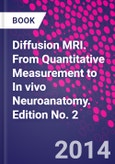Diffusion MRI remains the most comprehensive reference for understanding this rapidly evolving and powerful technology and is an essential handbook for designing, analyzing, and interpreting diffusion MR experiments.
Diffusion imaging provides a unique window on human brain anatomy. This non-invasive technique continues to grow in popularity as a way to study brain pathways that could never before be investigated in vivo.
This book covers the fundamental theory of diffusion imaging, discusses its most promising applications to basic and clinical neuroscience, and introduces cutting-edge methodological developments that will shape the field in coming years. Written by leading experts in the field, it places the exciting new results emerging from diffusion imaging in the context of classical anatomical techniques to show where diffusion studies might offer unique insights and where potential limitations lie.
Please Note: This is an On Demand product, delivery may take up to 11 working days after payment has been received.
Table of Contents
Section I: Introduction to Diffusion MRI 1. Introduction to diffusion MR 2. Pulse Sequences for Diffusion-Weighted MRI 3. Diffusion Acquisition: Pushing the Boundaries 4. Geometric Distortions in Diffusion MRI 5. Gaussian Modeling of the Diffusion Signal 6. Multiple Fibers: Beyond the Diffusion Tensor
Section II: Diffusion MRI for Quantitative Measurement 7. White Matter Structure: A Microscopist's View 8. The Biological Basis of Diffusion Anisotropy 9. Inferring Microstructural Information of White Matter from Diffusion MRI 10. Cross-Subject Comparison of Local Diffusion MRI Parameters 11. Diffusion MRI in Neurological Disorders 12. Diffusion Tensor Imaging in the Study of Aging and Age-Associated Neural Disease 13. Diffusion Imaging in teh Developing Brain 14. Individual Differences in White Matter Microstructure in the Healthy Brain 15. Diffusion Tensor Imaging and its Applications to Schizophrenia and Related Disorders
Section III: Diffusion MRI for In Vivo Neuroanatomy 16. Mapping Connections in Humans and Non-Human Primates: Aspirations and Challenges for Diffusion Imaging 17. Classic and Contemporary Neural Tract-Tracing Techniques 18. The Human Connectome: Linking Structure and Function in the Human Brain 19. MR Diffusion Tractography 20. Validation of Tractography 21. Connectivity Fingerprinting of Gray Matter 22. Contribution of Diffusion Tractography to the Anatomy of Language 23. Presurgical Tractography Applications 24. Comparing Connections in the Brains of Humans and Other Primates Using Diffusion-Weighted Imaging 25. Imaging Structure and Function








